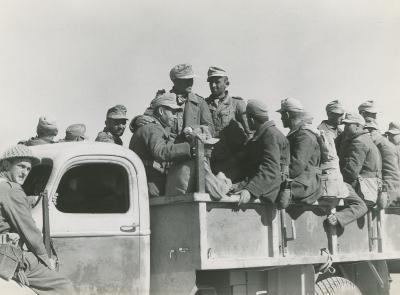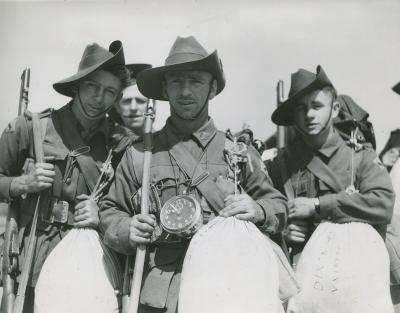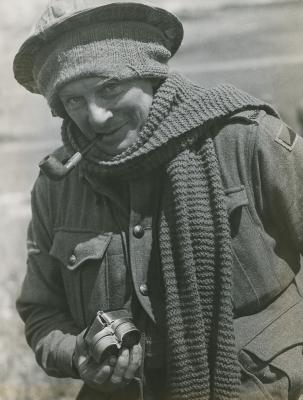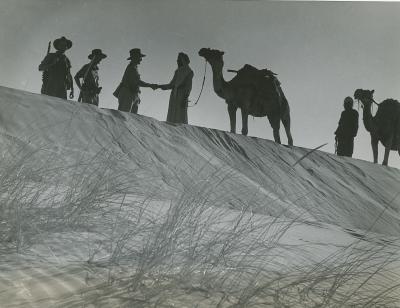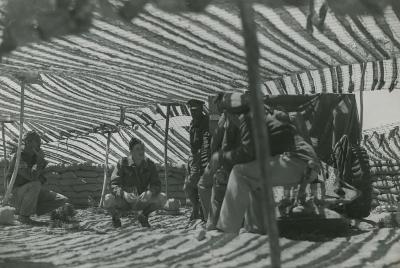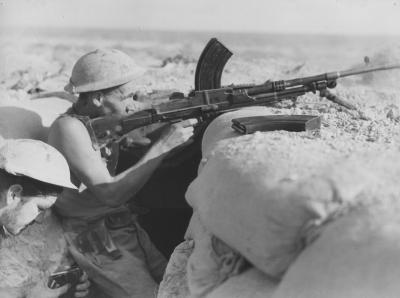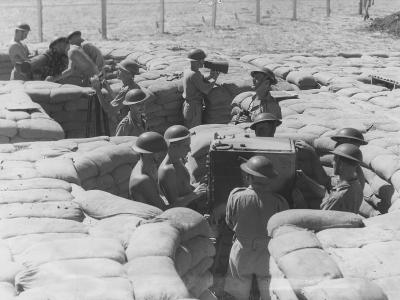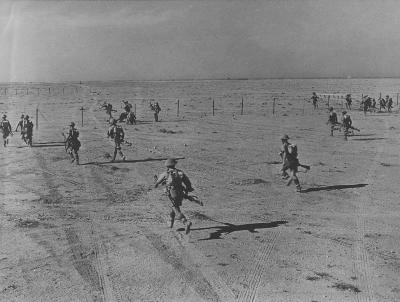World War 2, North Africa, Libya, Tobruk, 1941
1941View of outdoors bakery at Tobruk using Aldershot ovens
The Aldershot oven was a 'ground oven', in which the fire burns in the oven itself and has to be raked out before the bread is put in. This oven type is an extremely simple device, and follows a form which probably pre-dates recorded history. This particular pattern is English, and almost certainly 19th century in design. The bread is baked by the heat retained in the walls of the oven.
The oven is comprised of two sheets of iron, approximately 1500mm in length, rolled into a semi-circular shape. Each sheet is reinforced on each end and in the middle with iron bar, which is riveted to the sheet. One of the sheets is slightly larger than the other, with a lip that slips under the rim of the other sheet. The oven includes two semi circular ends. All metal components show mild surface corrosion.
Aldershot ovens were erected in a row with a trench in front and with their backs and tops covered with turf or clay. Wood fires were set inside ovens and when a sufficient temperature was obtained fires are drawn, all ashes removed, and nine tins containing a total of 54 loaves at 2lbs each were set inside. The front of the oven was then placed in position and sealed. 1 lb of wood gave sufficient heat to bake 1 lb bread. 8 ovens could bake sufficient bread for an infantry brigade, in 5 batches.
These ovens were found in use throughout both World Wars, in circumstances where more permanent, industrial drawplate steam ovens would not have been available. Most bread baked on the Western Front originated in massive bakeries at Calais, capable of producing 500,000 lbs of bread per day.
Details
Details
Tobruk is a Mediterranean port with an excellent deep-water harbour. During World War 2, as a supply hub, it was important to both Allied and Axis forces. In January 1941, it was captured from the Italians by General Wavell's forces which included the Australian 6 Division. When Rommel drove across Cyrenaica towards Suez in April 1941, it was essential that Tobruk be held. The main infantry component of the defending force was the Australian 9th Division and 18 Brigade from 7th Division. Tobruk was surrounded and besieged from 11 April to 10 December 1941, when the Axis forces were driven back.
Many of the Australian defenders had been relieved during August and September 1941 but 2/13 Battalion remained throughout the siege.
Open in Google Maps
Nearest geotagged records:
Australian Army Museum of Western Australia
Australian Army Museum of Western Australia
Other items from Australian Army Museum of Western Australia
- World War 2, Middle East, 1941
- World War 2, North Africa, Libya, 1941
- World War 2, Middle East, 1941
- World War 2, Middle East, DIXON, 2/14 Battalion, 1941
- World War 2, Australia, NETTLESHIP, 1941
- World War 2, Middle East, 1941
- World War 2, Middle East, 1941
- World War 2, Middle East, 1941
- World War 2, Middle East, 1941
- World War 2, Middle East, Western Desert, 1941
- World War 2, Middle East, 1941
- World War 2, Middle East , 1941

